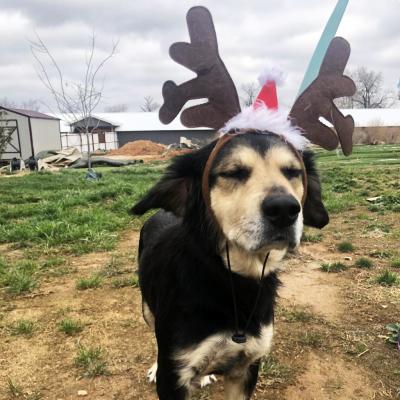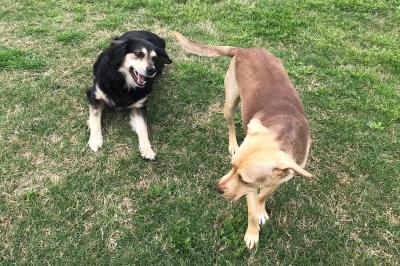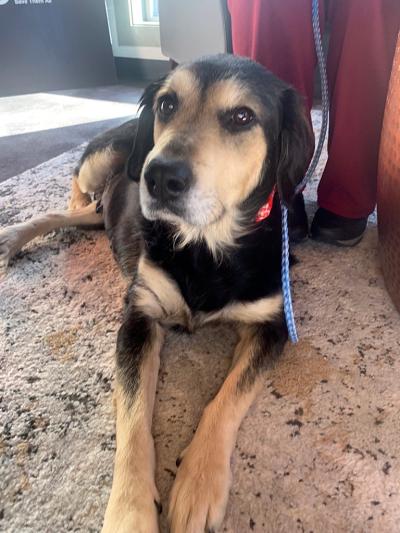A perfect storybook ending for a mama dog in need

Judy Barton was taking a break from fostering, but over email and social media she kept seeing calls for someone who could provide a temporary home for a mama dog and five pups. Judy thought of them as the “Reindeer Family.” It was getting close to the holidays for the mama dog (named Rein) and her pups (named after Santa’s famous sleigh crew). Judy thought they’d be spoken for. They were so cute. How had no one yet raised a hand to foster them?
The day before the Reindeer Family was to be transported from Pine Bluff Animal Shelter in Arkansas to Best Friends in Northwest Arkansas, Judy sent an email to Ronni Weber, a Best Friends supervisor. “I’m sure that she’s already been spoken for, but in case she hasn’t, I will consider taking her and her puppies.” Ronni replied: “Nope, nobody has raised their hand yet. When do you want her?”
For Judy, this was an oh-my-gosh-and-what-do-I-do-now moment. When she saw Ronni’s responses, she was excited but she also wasn’t sure how she would manage a full litter of pups and a mama dog (all possibly needing medical care) in addition to her own two dogs, Merlee and Baygus.
She couldn’t have known that Rein would become her third dog, or that what was feeling at first like a daunting new experience would turn out to be a blessing (the fulfilment of the promise she made to her Akita, Kuma, her first and most beloved foster failure).
Judy had promised Kuma (and herself) that she would keep fostering and that she would always be caring for someone. This promise worked like water over rock — ever present, smoothing and shaping, and cutting new grooves. It’s how Judy found herself with her hand up and in the flow of that promise.

Setting up a mom dog and pups for success
While Judy and Ronni were still making plans for how Judy might foster the Reindeer family, they arrived at Best Friends. When Sarah Lorenzen, medical coordinator, first met the exhausted mama dog and her five pups, she thought they looked like five fuzzy little bears more than they did reindeer. And they were ridiculously cute.
[First-time foster volunteers team up for a mama dog and her 14 puppies]
When the pups started trying to eat the dry kibble from Rein’s bowl, Sarah knew they were weaned and old enough to be separated from their mother. This was good news: Another foster volunteer could take four of the reindeer pups and Judy could just focus on caring for Rein and the one pup, Prancer.
Both dogs had skin conditions, with Rein showing significant hair loss and Prancer missing just one small round patch of fur. Most of the fur on Rein’s hips, thighs and stomach was gone, and she was clearly itchy. Judy and the vet team would later learn that the skin beneath her fur was dark, a sign of bites from the parasitic mites that cause sarcoptic mange, which is contagious. She also learned that Rein had heartworm and something else that seemed odd: Rein never lifted her tail. What was that about?

Daily groove of care creates a connection
Judy kept Rein and Prancer separate from her dogs, but every morning she let them all out to potty, fed them breakfast and worked through the day’s care priorities. Each day she vacuumed and steam-cleaned the floor (which was admittedly a lot of work but kept the house fresh and tidy), sprayed an anti-parasite product on the floors and walls, and gave prescribed medications. Every other day, she washed the dog bed sheets.
Until ringworm could be ruled out as the cause of Rein’s skin condition, Judy spritzed Rein with lime sulfur spray. She already had a head start on the mange because Rein, from the moment she arrived in foster care, had received a monthly flea and tick preventative that also treats mange. Finding out that the official diagnosis was mange was good news for a variety of reasons, not the least of which was they could get rid of the lime sulfur spray, which everyone found unpleasant.
Judy also took Rein in for her first heartworm treatment injection and vet visits arranged by Best Friends. She was also in regular contact with Best Friends staff regarding the health of both dogs. Then just a month after they arrived at Judy’s, little Prancer was adopted, and once she’d gone to her new home, it was just Rein, Judy’s dogs and Judy.
[6 unexpected benefits of fostering a dog during heartworm treatment]
By now, Rein was receiving two baths a week just to soothe her skin and make her feel better. On the days she didn’t seem to be feeling well (sometimes dealing with the side effect of an upset stomach from the heartworm treatment), Judy prepared for her a bland diet of poached chicken and white rice with lots of water for hydration. Rein improved and the mange was brought under control.

Foster volunteer’s keen eye, vet care brings relief
Everything was going well, but Judy couldn’t understand Rein’s tucked tail. Was she feeling stressed and unhappy even when it seemed like she should be feeling more comfortable? Judy just kept noticing that when she was talking to Rein or giving her treats, the top part of her tail would move a bit, but the lower part was still.
A vet examination determined that Rein had likely experienced some trauma that had paralyzed her tail. And when the vet mentioned the possibility of removing Rein’s tail, Judy was stunned. Cut off Rein’s beautiful tail? After voicing her concerns, the vet decided that it was OK to hold off on the surgery, as long as Rein’s tail didn’t seem to be bothering her. But later, while Judy rocked in her rocking chair with Rein sitting next to her (as had become their custom), she felt some resistance under her as she rocked. It was Rein’s tail. She suddenly remembered that Prancer had chewed on Rein’s tail and Rein had never reacted. Clearly, Rein couldn’t feel her tail or control it at all.
After Judy and the Best Friends team shared their information with the vet scheduled to do Rein’s spay surgery, it was decided that, in order to prevent further injury, an amputation was appropriate. And shortly after that when Rein went in for her spay surgery, her paralyzed tail was removed. She didn’t seem to mind one bit.
Through all this, Rein and Judy formed a deep connection. Rein got along well with Judy’s dogs and gave Baygus (the slightly ornery one) his space. She also knew that Merlee, the playful one, was good for a game (though Rein likes to play a bit rougher than Merlee). When the weather was good, Judy took them for strolls around the block together. They fell into a routine.

Three dogs can stay, room for one more
Rein fit in so beautifully with the family that Judy thought about adopting her permanently. But just as she was about ready to tell the Best Friends team that news, someone else applied to adopt Rein. After mulling it over, Judy decided to let Rein go, thinking of the many dogs needing care and that she should remain open to that. It was hard and she wasn’t happy about it. (In fact, she was quite sad.) But she felt that in the grand scheme of things, it was the right thing to do.
Rein went home with the other adopter, but after a short time they brought her back to Best Friends. They felt Rein just wasn’t the right fit for them. When Judy heard, she didn’t hesitate. Rein could come back to her house.
[Foster sees beyond dog's heartworm status and adopts her]
Where Judy lives, residents are allowed to have four dogs. If Rein were to stay, Judy thought, she’d still have room to foster another dog. Plus, having Rein back, she realized how much she’d missed her and she didn’t want to miss her anymore. She would adopt Rein. And she would still foster. She would keep her promise.

Moving toward full recovery in a new home
Rein is still being treated for heartworm. (She’s had all her injections and is being monitored to be sure there are no lingering immature heartworms.) But now she acts like a happy, healthy dog and she has a beautiful coat. Judy is fostering Lula (short for Tallulah), who though recovering from heartworm is perfectly willing to play rough and rowdy with Rein. Judy says Rein walks “both sides of the play fence” with all the dogs she lives with. She can be playful but also gentle. She fits in, and while she’s “a dog’s dog,” Rein also enjoys spending time with her and that makes her happy.
Sarah, who first spotted Rein when she arrived at Best Friends feeling miserable and at her lowest point, believes the adoption was fate. Rein persevered through so much: tending to her pups, enduring life with a paralyzed tail, and recovering from mange mite infection and heartworm. And though it wasn't clear at first, today it's easy to see that Rein was meant to be with Judy.
“Like an idiot,” says Judy, “I raised my hand. But now I’m glad I did because I have a new dog. I just kind of fell into it.”
As it turned out, Judy had fallen into a familiar routine — one she already knew. With her new dog, Rein, she has yet another friend to help shape her days and fill them with purpose.

Fostering saves lives
Got a little time to spare? Fostering pets makes an incredible difference in their lives, no matter how much time you have to give.
Read more
Dog with incontinence, heartworm proves that love always wins